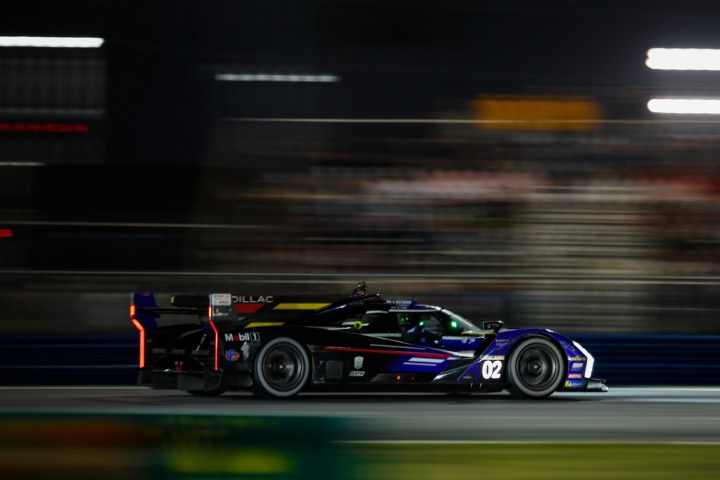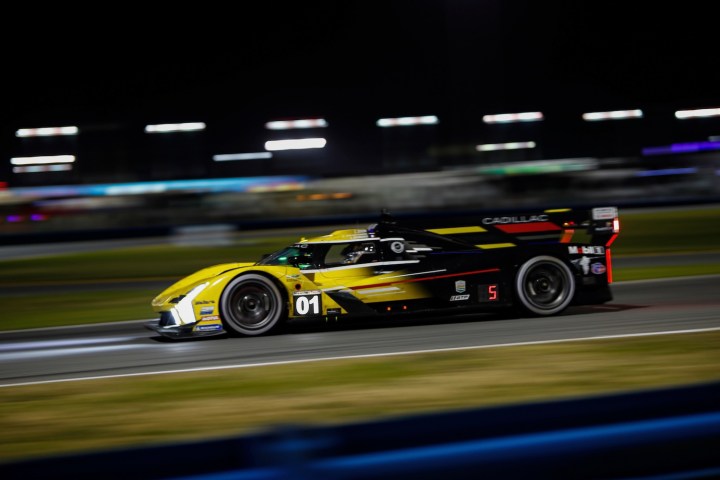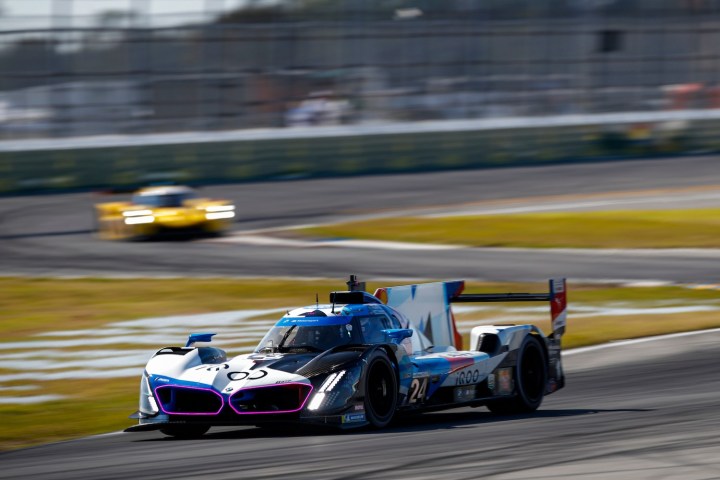Racing is the soul of the auto industry. It’s the purest expression of the engineering that makes cars possible, and the thing they were engineered to do in the first place — be driven. While it can be full of arcane rules that make government regulations and customer clinics seem like child’s play, racing is where cars are built to be cars, and where drivers are just drivers. And like the rest of the industry, the racing world is now grappling with the need for electrification.
Many automakers have built their reputations on the track, and some are hoping to sprinkle a bit of that motorsports magic dust on their plans to curb internal-combustion engines. Acura, BMW, Cadillac, and Porsche just debuted hybrid race cars in the Rolex 24 at Daytona, a 24-hour race held at Florida’s Daytona International Speedway that’s one of the biggest events on the racing calendar.
All of the participating automakers plan to limit — or in some cases eliminate — standalone internal combustion engines from their road cars in the coming years. These race cars — the Acura ARX-06, BMW M Hybrid V8, Cadillac V-LMDh, and Porsche 963 — are a step toward aligning the automakers’ racing programs with those goals. But a lot more went into choosing this specific form of electrified racing than the admirable goal of swapping hydrocarbons for electrons.
Rewriting the rulebook
The new cars are built to a set of rules called LMDh, short for Le Mans Daytona hybrid, signifying the two marquee races the cars were designed to run. In a rare moment of cooperation, the International Motor Sports Association (IMSA), which organizes the Daytona 24-hour race and the accompanying WeatherTech SportsCar Championship, synced up its rules with those of the Automobile Club de l’Ouest (ACO), which runs the legendary 24 Hours of Le Mans, allowing the LMDh cars to run in both races. IMSA then re-branded the LMDh rule package as GTP (Grand Touring Prototype), reviving a popular class name from the 1980s.
After input from the automakers, IMSA and the ACO came up with a common hybrid system and a shortlist of chassis from dedicated racing manufacturers. Automakers can then customize these with their own internal-combustion engines and bodywork.
Whatever engine automakers choose has to be coupled to a series-specific hybrid system, including a small battery pack and a motor generator unit (MGU) that can help power the rear wheels or harvest energy via regenerative braking. Output is capped at 670 horsepower, with the hybrid system providing just 40 to 67 hp, depending on the track, plus the ability to run on all-electric power at low speeds, such as when driving down the pit lane or in and out of garages. It’s a token amount of electrification, but it was still enough to get automakers interested.
From road to track
All forms of racing live and die by manufacturer participation, but that’s particularly true of the type promoted by IMSA, known as sports car racing. Where series like Formula One and NASCAR have developed their own brands, sports car racing relies on manufacturers to stock the field with cars and provide clear storylines amid a confusing array of classes and a rotating cast of drivers. In sports car racing, the cars are the stars.
That’s why IMSA chose the GTP name for this new class of hybrid racers. The original GTP era was IMSA’s golden age, and that’s because it featured intense competition between automakers like current GTP entrants Acura, BMW, and Porsche, as well as Chevrolet, Jaguar, Nissan, and Toyota, among others, which produced cars with the reductive design of an eight-bit video game and the raw power of earthbound jet fighters.
After the original GTP era ended, organizers worked through a number of different formats, with various levels of manufacturer interest. When the time came to replace the outgoing generation of cars, known as DPi (Daytona Prototype international), hybrids were a must.
In sports car racing, the cars are the stars.
“It’s a natural progression,” Michael Shank, owner of Meyer Shank Racing, one of the teams that made the switch from DPi to GTP, which would go on to win Daytona with its number 60 Acura ARX-06, said in a pre-race press conference. The added complexity of the hybrid system made getting the new car ready a “soul-sucking” experience, Shank said, but he maintained electrification was necessary to keep automakers engaged.
Looking at the grid for the Daytona race, it’s hard to argue with that. In addition to convincing both Acura and Cadillac to re-up, the rules change brought in BMW and Porsche. For Porsche, which racked up numerous wins with its 962 in the original GTP era, hybrid power was also the deciding factor because it ties into road-car electrification plans.
“To race with a hybrid was for sure one of the vital points for us, no question,” Thomas Laudenbach, Porsche global vice president of motorsport, told Digital Trends. “Motorsport, if you do it as an OEM [original equipment manufacturer], if you do it as a company, needs to be relevant for what you do on the road, he said. “We have electrification, it’s coming in a wide range, so therefore for us, it’s clear that motorsport has to take this and bring it also to the racetrack.”
The sweet spot of electrification
How much electrification was enough? One plan for a more limited “push to pass” system would have only employed electric power for overtaking other cars, IMSA president John Doonan told Digital Trends. He said the final package was a “sweet spot” compromise that let automakers claim some relevance to their electrification plans while still preserving the sound and fury of traditional racing — and keeping costs reasonable.
“The OEMs sort of had a ‘save us from ourselves’ mentality,” Doonan said, explaining that manufacturers wanted the restrictive rules that force everyone to use the same hybrid system in order to avoid the temptation of spending lots of money to gain an advantage.
The final package was a “sweet spot” compromise.
A look at recent history bears this out. Formula One mandated hybrid powertrains for the 2014 season, which firmly shifted the competitive advantage to a handful of wealthy teams with the cash to fully develop these complex powertrains. Organizers have been trying to correct this imbalance ever since.
Hybrid powertrains also became the main attraction at the 24 Hours of Le Mans in 2012, with more open rules than the current GTP set. This produced cars that were technological marvels, but also drained automaker budgets, causing them to lose interest quickly. As mentioned earlier, Le Mans organizer the ACO is now adopting a rule set closer to IMSA’s.
A high-speed canvas
The GTP rules also give automakers a chance to show off in another important way — design. Race cars are usually function over form, but GTP encourages automotive design teams to put their own spin on the cars, resulting in machines that look like they’re auditioning to be the next Batmobile.
“We approached it like a project in our studio,” Acura executive creative director Dave Marek, said in the Daytona garages as the pair of sleek ARX-06 race cars that started as sketches and clay models in the same California design studio that styles Acura luxury sedans were prepped for their next track outings. “On 85% of the car, we were free to do what we wanted.”
The cars look like they’re auditioning to be the next Batmobile.
“It’s not like we just got handed a bunch of criteria,” Chris Mikalauskas, designer of the Cadillac V-LMDh said as his handiwork flew past Daytona’s grandstands. Aside from the basic cockpit of the car, which was supplied by chassis maker Dallara, Mikalauskas had free reign to design the Cadillac of race cars, working collaboratively with engineers to ensure the design met all of the practical requirements. With their brand-specific styling, cars like the V-LMDh are much more exciting to look at than the anonymous designs that are the norm for purpose-built race cars.
“Seeing a bunch of homologated cars go around in circles isn’t the most exciting thing to people outside of racing,” Mikalauskas said. “The idea of a cookie cutter car that says ‘Cadillac’ wouldn’t have had the same impact.”
Software-defined
Beyond the talk of road-relevant hybrid powertrains and bodywork styled by road-car designers, the GTP racers have another, less glamorous, connection to ordinary cars: their behavior is largely defined by software.
Filtering driver inputs through software is how Porsche gets its Cayenne SUV to handle like a sports car, and the same principle applies to race cars like the automaker’s 963. Only instead of weaving an electronic safety net to ensure an overconfident investment banker doesn’t end up in a ditch, GTP cars use software to determine the blend of gasoline and electric power, as well as the behavior of the brakes. Rear braking is entirely computer-controlled, an approach deemed necessary to balance the needs of deceleration and battery charging, which isn’t much comfort to a driver trying to learn about their car.
“It’s basically trying to keep up with what you’re asking on the software side, managing how much is coming from the electric motor, how much is coming from the hydraulic lines,” Dane Cameron said of one of the Porsche 963 he shared with two other drivers for the 24-hour race. “You don’t really know.”

“There’s so much done by the computer,” Tom Blomqvist, one of the drivers of the winning number 60 Acura, said. “If that’s not quite right, then it obviously has a big impact on the drivability.” It didn’t seem to have too much of an impact, as Blomqvist achieved the quickest lap time in qualifying, ensuring the number 60 car started first on the grid.
“On the power side it’s not so different,” Colin Braun, one of the drivers of the winning number 60 Acura, said, “but on the braking side there’s so much going on.” With the software dialed in, though, Braun said the overall feel “is not so massively different” from non-hybrid cars. The use of electric power is also completely opaque.
“The car pretty much does all that,” Braun said. “On our end, we’re really not doing a whole lot.” Rather than the electric element, Braun and the other drivers we talked to said that the biggest differences in drivability came from the added weight and power of the new cars, as well as a reduction in grip-generating downforce. These hybrids don’t even change how the drivers save fuel.
“It’s basically like in the past,” Blomqvist said. “The same philosophy, same techniques apply to that.”
What’s next?
That familiarity for drivers produced some good racing between the Acuras and Cadillacs, which battled for the lead through the Florida night. The BMWs and Porsches were further off the pace and experienced some reliability issues, but that’s typical in a 24-hour race. Overall, it was a solid first showing for the GTP cars, but what comes next?
Over the next few years, all of the automakers involved in GTP will add more EVs to their lineups. Acura will launch its first EV in 2024, BMW is poised to launch next-generation models dubbed “Neue Klasse” (German for “new class”) in 2025, Porsche is readying an electric version of its bestselling Macan SUV, and Cadillac aims to go all-electric by the end of the decade. At some point, GTP’s hybrid-lite powertrains won’t be that relevant to road cars, but all-electric racing has its own challenges.
Some race series, like Formula E, have made electric cars work for shorter races, but range and charging times would be an issue for longer races like Daytona, IMSA president John Doonan said. He also wonders whether near-silent electric cars will appeal to fans.

“The sounds, the smells, the senses of our sport are still really important, and we can’t forget that.”
Porsche global motorsport VP Thomas Laudenbach also raised issues of limited range and long charging times, adding that Porsche isn’t in a hurry to electrify all forms of racing. Between the 963 hybrid, Formula E, and remaining pure internal-combustion race cars, he believes Porsche has already achieved a split between hybrid, EV, and pure gasoline racing that reflects its road-car lineup.
“We try to serve all three pillars of that, and that’s fine for us because if you take all three, that’s exactly what we do on public roads.”
That comparison may become too much of a stretch as automakers start selling more EVs and the gap between those cars and IMSA’s purpose-built GTP hybrids widens. It’s impossible to predict how quickly the EV shift will happen, but for now, the GTP class lets manufacturers stay in the racing game. Even a small amount of electrification is enough to justify spending millions on racing, without making participation prohibitively expensive, while fans have something new to get excited about. As compromises go, it’s a good one.
Editors' Recommendations
- Porsche’s most powerful production car is an EV
- Remember that burning ship carrying luxury cars? It sank
- How a big blue van from 1986 paved the way for self-driving cars
- Porsche’s second electric model is a sports car in hiking boots
- Apple in talks with Hyundai over possible car, automaker confirms







